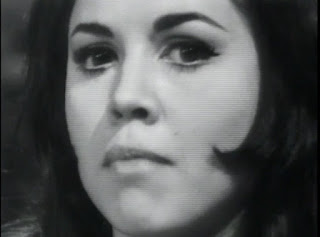Armchair Theatre was a drama anthology series of single plays, produced by Associated British Corporation (ABC) (and later by Thames Television), which ran in the UK on the ITV channel on Sunday nights from 1956 to 1974.
Jocelyn (as Jackie Lane) appeared in an episode called Afternoon of a Nymph, which was shot in black and white and originally aired on September 30, 1962. In that episode, the viewer follows a day in the life of a young starlet named Elaine (Janet Munro). She lives with her parents, and her mother frets about her activities as she gets ready to go out for "meetings." Elaine spins it all to her mother as a chance at a glamorous career.
Elaine meets her agent at a restaurant where the starlets and entertainment brass hang out. Immediately, we get the sense that this is a sleazy business. One of the starlets, Ginger (Jocelyn), is hanging out at the bar, and we learn that she is considered a trashy starlet that will do anything to play the entertainment game. Elaine considers herself to be above all of that, but her agent encourages her to go to a party that night to rub elbows with important people.
We follow Elaine as she goes to a set to film what appears to be a production of Romeo and Juliet. However, it turns out to be a candy commercial. The director of the commercial, David (Ian Hendry, who would marry Munro the following year) comes on to Elaine, and they have a lot of back-and-forth about the business and how hard she wants to make it.
The episode concludes at the party that night, where we see how superficial everyone can be and how the desperate starlets are used and discarded, eating away at their souls. It turns out that Ginger is a lesbian, as she comes-on to Elaine in the powder room. Ultimately, the 58-minute story is a depressing look at the sleaziness and superficiality of the entertainment industry in regard to young starlets, showing how it can eat at their souls and sense of self-worth. My guess is that it was considered quite daring for British TV in that era.
I have not watched any other episodes of the series, but Afternoon of a Nymph is not recommended viewing in my book (For a more interesting take on a theme like this, I recommend the 1965 Italian film Io la conoscevo bene, starring Stefania Sandrelli.). The series is shot on whatever the equivalent of tape was at the time, not on film, so it has the look of an old soap opera. Jocelyn is far and away the prettiest female in the cast, besting Munro and April Wilding (as a blonde, Marilyn-Monroe-type starlet). Realistically, though, Jocelyn probably did not have the dramatic acting range to play the part of Elaine. Munro (best remembered for Darby O'Gill and the Little People and Swiss Family Robinson) was probably more suited for that part. As Ginger, Jocelyn does an adequate job, with a slight British accent that is much easier for me to understand than the thick accent of many of the other cast members. Her brunette hairstyle is similar to that shown in pictures from Operation Snatch.
I am yet again puzzled as to why Jocelyn was appearing in small roles in productions like this. Why were producers not keeping her busy with more substantial big screen roles that played to her strong points? Unless you are a fan of classic British television or a Jocelyn Lane completist, you haven't missed much, if you do not get around to watching Afternoon of a Nymph.
Afternoon of a Nymph is one of the episodes included in an Armchair Theatre DVD release in the UK in 2012.
In addition to the pictures at the top of this post, here are a few captures to give you an idea about Jocelyn's appearance in this production.
Finally, here is some interesting back-story. This episode was written by Robert Muller, who had written a book published in 1958 called Cinderella Nightingale, which was a "sizzling, up-to-the-minute close-up of the amoral machine that turns a beautiful body into big business" that mirrored the theme in Afternoon of a Nymph. Although Diana Dors or Carole Lesley were said by some to be the real inspiration for the book, he was sued by a British starlet called Sabrina (real name Norma Ann Sykes), who claimed that the book was clearly based on her and had libeled her and her father. Sabrina won her lawsuit, got an apology from Muller, got copies of the book withdrawn from sale, and derailed a planned film production of the book that was to star Carole Lesley. Sabrina agreed that the book could be republished with offending passages removed, so it was released again in 1962 (the year that Afternoon of a Nymph aired).
Not only did Muller employ the book's theme in Afternoon of a Nymph, he also employed it in the script that he co-wrote with Val Guest for The Beauty Jungle (aka Contest Girl) released in 1964, starring Janette Scott and Ian Hendry.






































